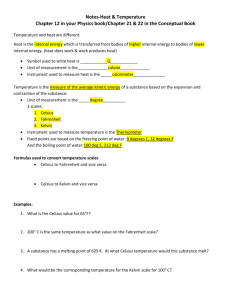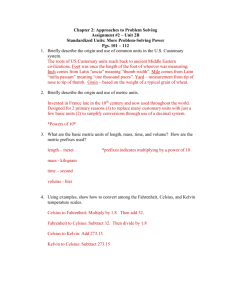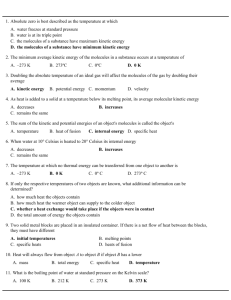Unit 2 PowerPoint
advertisement
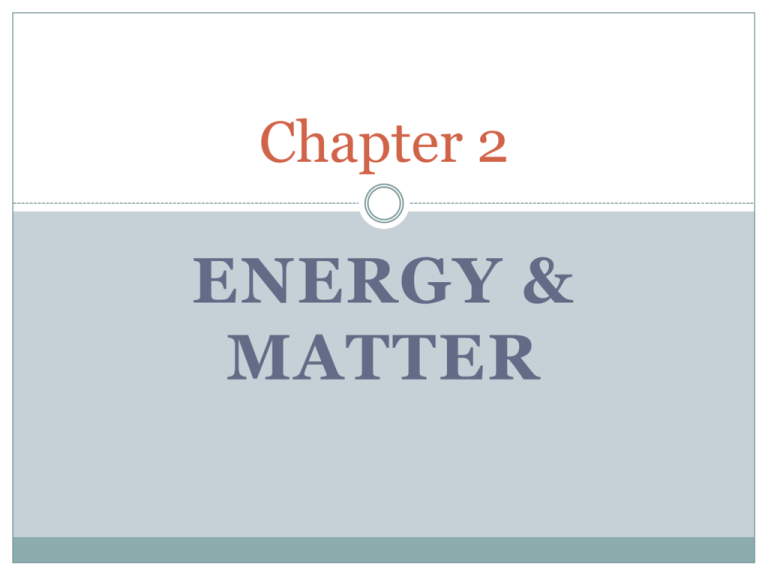
Chapter 2 ENERGY & MATTER Wednesday, 10/1/14 Learning Target: Know the 3 basic forms of energy and how energy is calculated. Learning Outcome: I will complete energy conversion problems. What is Energy? The capacity to do work or produce heat. Law of Conservation of Energy Energy can neither be created nor destroyed in any chemical or physical process. It can be converted from one form to another. https://www.youtube.com/watch?v=qybUFnY7Y8w Greenhouse Effect 2-1 Energy • Energy is classified into three main forms • Radiant • Kinetic & • Potential Radiant Energy This is energy from the Sun which is the result of nuclear fusion Kinetic Energy This is the energy carried by objects in motion, like a locomotive. Kinetic Energy includes: 1. Mechanical energy carried by the moving parts of a machine 2. Thermal Energy of the random internal motion of particles in all substances Kinetic Energy (KE) KE = ½ mv2 KE = kinetic energy Unit J = Joule (kg.m2/s2) m = mass kg v = velocity m/sec Calculate the KE of a 70.kg person walking at 2.5m/s. Potential Energy This is the energy possessed by objects because of the position or the arrangement of their particles In essence it is stored energy. Types of Gravitational Potential Energy 1. 2. 3. Gravitational Electrical – different electrical charges Chemical – Fuels and Food Energy stored in food is often given a unit that is related to the calorie. The Calorie (Cal) is 1000cal or 1 kilocalorie. The SI Unit of energy is the Joule (J) Joule in the long form is kg.m2/s2 4.184J = 1 cal 4.184 KJoule = 1Kcal or 1Cal 1 KJ = 1000 J 1 Cal = 1000 cal Calorie (cal) [older unit] The amount of energy required to raise the temperature of 1 gram of water by 1 degree Celsius. 1cal =4.184 joules chocolate bar=200 Cal 200Cal x 4.184 KJ/Cal= Energy in one chocolate bar= 836.8KJ Thursday, 10/2/14 Learning Target: Know what temperature is the measure of and how to convert between Kelvin, Celsius and Fahrenheit temperature scales. Learning Outcome: I will complete temperature conversion problems. Thermometer The modern thermometer used in our class is filled with colored alcohol. As the bulb is heated or cooled the liquid with expand or contract. Thermal Energy (Heat) Sum total of all the KE of the particles in a sample. This can only be measured using indirect means when a change of heat occurs. Temperature Measure of the average KE of the particles in a sample. Can be measured directly. The Celsius Temperature Scale The freezing point of pure water at sea level is 0º C. The boiling point of pure water at sea level is 100º C. The Difference between Kelvin and Celsius The main difference is the location of the zero point. The zero point for kelvin is called absolute zero. Absolute zero is equal to -273.15º C or 0K. Absolute zero is the point at which the motion of particles of matter has completely stopped. Kelvin Temperature Scale SI Unit for temperature is Kelvin (K). The degree unit is not used in Kelvin (K), Converting Kelvin and Celsius ºC = K – 273.15 K = ºC + 273.15 For example, the boiling point of water is 100 ºC is 373.15 K. K = 100 ºC + 273.15 K = 373.15 K Convert 50. K to the Celsius scale ºC = K – 273.15 ºC = 50. K – 273.15 ºC = -223.15 ºC Converting Fahrenheit to Celsius ºC = (ºF – 32) x 5/9 Convert 67°F to °C ºC = (67º – 32) x 5/9 = 19.4 ºC Converting Celsius to Fahrenheit ºF = 9/5 x (ºC) + 32 Convert -14 ºC to ºF ºF = 9/5 x (-14º) + 32 = 6.8ºF Wednesday, 10/3/14 Learning Target: Understand the characteristic differences between physical changes and chemical changes of matter. Learning Outcome: I correctly identify physical changes and chemical changes that are demonstrated. Properties of Matter Extensive Properties-properties that are dependent on the quantity of matter. (mass, volume, shape) Intensive Properties-Not dependent on the size of the sample, characteristic properties of that substance. (melting point, boiling point, density) Indicators of Chemical Change 1. Evolution of heat and/or light. 2. Production of a gas (not from boiling) 3. Production of a precipitate (ppt.) (solid but not from freezing) 4. Color change (be careful with this one, indicators cause color change but that is not chemical!) Physical vs. Chemical Examples: rusting iron dissolving in water Chemical Chemical burning a log Chemical melting ice Physical grinding spices Physical Thursday, 10/6/14 Learning Target: Explain the differences between elements, compounds and mixtures (heterogeneous and homogeneous). Learning Outcome: I will pre-lab for the Separation of Mixtures Lab. What is matter? Anything that has mass and takes up space. Matter is broken up into two ways: 1. Pure Substances 2. Mixtures 5 States of Matter [Actually 4 States] Bose-Einstein Condensate – very low volume, close to absolute zero. Solid-definite shape & volume, maintains shape. Liquid-definite volume but indefinite shape, takes the shape of its container but does not fill. Gas-indefinite shape & volume, fills any container placed in. Plasma-highly ionized form of gas that exists at high temps. (surface of the stars, fluorescent lights) Physical Characteristics Physical Properties-These are observed or tested without changing the substance. Physical change -These include changes of state such as melting, boiling, dissolving, grinding, filtering. Chemical Characteristics Chemical Properties-How a substance reacts with other substances. This is only observed in a chemical reaction. Chemical Change-When a substance is converted into a new substance. All properties and characteristics will change! Format: Reactants (start) Products (yields) (ending) Pure Substances Elements & Compounds These always have the same properties The same composition They can not be separated without changing properties. Element A substance that can not be broken down into another substance by chemical means. The smallest part is an atom There are approximately 90 naturally occurring elements. Compound A substance that can be broken down into another substance by chemical means. The smallest part is a molecule or ion. Mixtures Mixture-Physical combination of 2 or more substances. 2 Classifications: Heterogeneous-different composition present [examples: sand, granite, blood] Homogeneous-same composition present throughout [examples: salt water, coffee, apple juice] Separation of Mixtures separate mixtures based on different physical properties of the components Different Physical Property Technique Boiling Point Distillation State of Matter (solid/liquid/gas) Filtration Dissolves in water Evaporation Filtration Evaporation Liquid vaporizes leaving less volatile liquid or solid. Distillation Tuesday, 10/6/14 Learning Target: Explain the differences heterogeneous and homogeneous mixtures, and know techniques used to separate them. Learning Outcome: I will complete the separation of mixtures lab. Physical vs. Chemical Examples: melting point physical flammable chemical density physical magnetic physical tarnishes air in chemical WARM UP A runner burns about 10. kcal per minute. If the runner completes a race in one hour and fourteen minutes, how many kJ did he burn? How many J did he burn? WARM UP A runner burns about 740 kcal in a cross country race, how many kJ did she burn? How many J did she burn?

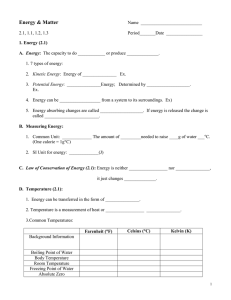
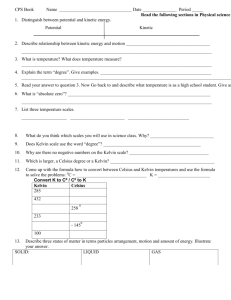
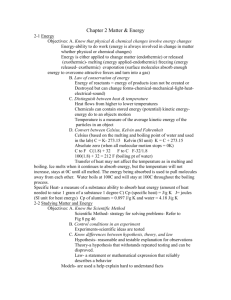
![Temperature Notes [9/22/2015]](http://s3.studylib.net/store/data/006907012_1-3fc2d93efdacd086a05519765259a482-300x300.png)
